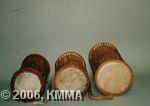

The donno drum is a laced, double-headed hourglass-shaped drum which is hung across the shoulder with a strap. The donno drum belongs to the family of the closed drums. The donno drums are carved out of cedar wood (tweneboa) or the wood of bontodie or nkranku, and have skin membrane at both ends. The ends are round in shape and of the same size, but taper towards the middle of the drum. The middle portion is narrow and cylindrical, and is regarded as 'the nek' of the drum, that is the link between the two ends. Small loops about an inch in width are attaches to the edges of the skin. Vertical strings of skin or gut run from one end of the drum to the other through these loops, to keep the skin drum surface in position and in approximately equal tension (Nketia, 1957,p14) The pitch can be changed by pressing down the straps, which hold the two membranes together, with the arm under the armpit. This tightens both membranes and produces a higher sound when the instrument is struck. In some cases, seeds or small stones are put inside the drum. This gives a special effect, and colours the sound of the drum. The donno drum is used to accompany dances and songs.
The Akan sometimes use the term dondon when they mean donno. Among the Dagomba and the Mamprusi this drum is called the lunga, among the Sissala singsenge, among the Kassena gungonga, and among the Frafra lung doo. They are all hourglass-shaped drums with slight differences in shape, size and function within the group.
© RMCA/Dominik PHYFFEROEN